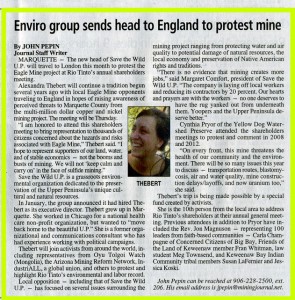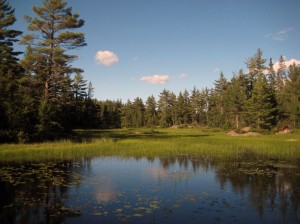BERGLAND — On Sunday, August 18th, the Trap Hills Conservation Alliance (THCA) and Save the Wild U.P. (SWUP) hosted an inaugural day of events celebrating the Trap Hills, a rarely-visited scenic area featuring stunning views, at the Bergland Township Park.
Participants traveled from places as near as Wakefield and as far as Big Bay, Houghton, and Duluth for the event. Nearly 30 hikers, ages 5 and up, enjoyed guided hikes on the North Country Trail and the Cascade Falls Trails north of Bergland. Wisconsin folksinger Skip Jones played tunes inspired by nature and labor history as hikers enjoyed a free picnic lunch from local businesses.
Nona Trealoff of SoulsShine in Hudson, Wisc. led a blessings ceremony on the shore of Lake Gogebic prior to the hike. Said Margaret Comfort, president of SWUP, “The Trap Hills are indeed a blessing to behold! We are proud to host this free day of events in conjunction with the Trap Hills Conservation Alliance, as we seek to educate the public and introduce them to the splendor of this truly magical place.”
Two hikes, led by botanist Steve Garske and geologist and retired Ottawa National
Forest wilderness ranger Doug Welker, featured 40-mile views from the edge of a spectacular rock bluff, a trip to Cascade Falls, and a vista that included a 350-foot sheer cliff, the highest in Michigan.
As Welker noted, the Trap Hills are perhaps the most spectacular and fascinating of Michigan’s largely-undiscovered secrets. With high rock bluffs, seemingly endless views, remote and relatively pristine areas, Wild and Scenic Rivers, 50 miles of the North Country National Scenic Trail (NCT), numerous other trails including the Pioneer Multi-use Motorized Trail, and a long historic and prehistoric copper mining history (interpreted at Old Victoria and in area museums), it’s hard to find such a concentration of special places and recreational opportunities anywhere.
“That’s why some of us are working to get the Trap Hills designated as a federal National Recreation Area (NRA), to protect special areas, increase and promote recreational opportunities, and bring more recreation-related dollars into the local economy. Done right, it could be a win-win opportunity for the variety of diverse groups who would have a stake in both developing and protecting this area,” said Welker.
Steve Garske, local botanist and board member of Save the Wild U.P., said, “A Trap Hills National Recreation Area would help protect the beautiful Western U.P. and contribute to a sustainable economy for the region as well.”
SWUP Executive Director Alexandra Thebert agreed. “Many people who live just a few minutes away have never known about the Trap Hills. We’re dedicated to protecting the Trap Hills for future generations — and glad this will include even more hikes, cook-outs, and educational events!”
Assistant Surveyor and SWUP Advisory Board Member Richard Sloat added, “I’ve lived in the Western U.P most of my life, I have visited the Porkies but I had no idea an area of such beauty and geologic diversity as the Trap Hills area existed. Why? Nobody told me.”
Doug Welker can be reached at dwelker@up.net for more information on the North Country Trail or to get involved in crafting a National Recreation Area proposal.
A primer on the Trap Hills is available at http:// www.northcountrytrail.org/pwf/traphills.htm
Save the Wild U.P. is a grassroots organization focused on preserving the U.P.’s unique cultural and environmental resources. Visit SavetheWildUP.org for more information and to get involved.


